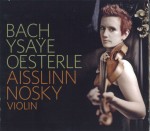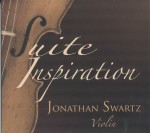
 Bach; Ysaÿe; Oesterle
Bach; Ysaÿe; Oesterle
Aisslinn Nosky
Independent IF004
www.aisslinn.com
Suite Inspiration
Jonathan Swartz
Soundset SR1039
www.Jonathan-Swartz.com
These are two fascinating discs both of which feature strong performances of the music for unaccompanied violin by J.S. Bach and other more modern pieces which reflect and refract the glorious light of Bach’s works.
The irrepressible and omnipresent Aisslinn Nosky is one of the Toronto music scene’s precious treasures. As this, her debut solo CD, proves, she is possessed of a rock-solid technique and an open and probing musical mind. Three extended pieces for solo violin make up the program: the Partita in E Major by Bach, Eugene Ysaÿe’s Sonata Op.27 No.2 and Stand Still, written especially for Nosky in 2011 by the German-Canadian composer Michael Oesterle.
Oesterle’s captivating piece is both minimalist and lyrical and exploits the “voice” of the violin to great effect. Nosky’s performance, with its varied dynamics and articulation, brings out the fanciful character of the music as well as its fragility. The Bach partita and Ysaÿe’s sonata are inextricably linked thematically and are both given luminous performances here. Nosky’s playing and musical intentions are crystal clear throughout and her free and bright sound is well supported by the fine production values of the disc.
The Toronto-born violinist Jonathan Swartz was educated at Rice University and Mannes College, and teaches at Arizona State University, where he is active as a soloist and chamber musician. His cleverly-titled CD Suite Inspiration is filled with dance movements for solo violin by Johann Georg Pisendel, J.S. Bach and the Canadian composer Kieren MacMillan. Following a chronological order, Swartz begins the disc with the weakest piece, unfortunately. Though it is given a convincing performance, Pisendel’s A Minor Sonata doesn’t have enough interest to either move or entertain. The highlight of the program is MacMillan’s Suite No.1 and intriguing Chaconne, which — with its hypnotic, circular patterns — provides a trance-inducing, deeply satisfying conclusion to Swartz’s program.
Both Nosky’s and Swartz’s performances of Bach’s works are brave and thoughtful. My fondest wish for both players – if it’s not too corny to say — is that they keep searching their hearts for ever deeper ways to bring this music across, and that they keep revisiting this repertoire, as I know they will, throughout their careers. There is a delicious sense of abandon in Nosky’s live playing that is captured thankfully in spades, in her recording of the E Major Partita, especially in the outer movements. Swartz’s performance of the D Minor Partita, with the biblically-proportioned final Chaconne, is a little more reserved and careful and is at times marred by questionable ornamentation choices.
These are two welcome additions to any violin-lover’s collection. Bravo to both players for commissioning new works from excellent, imaginative composers and for sharing their musical “voices” so generously.



